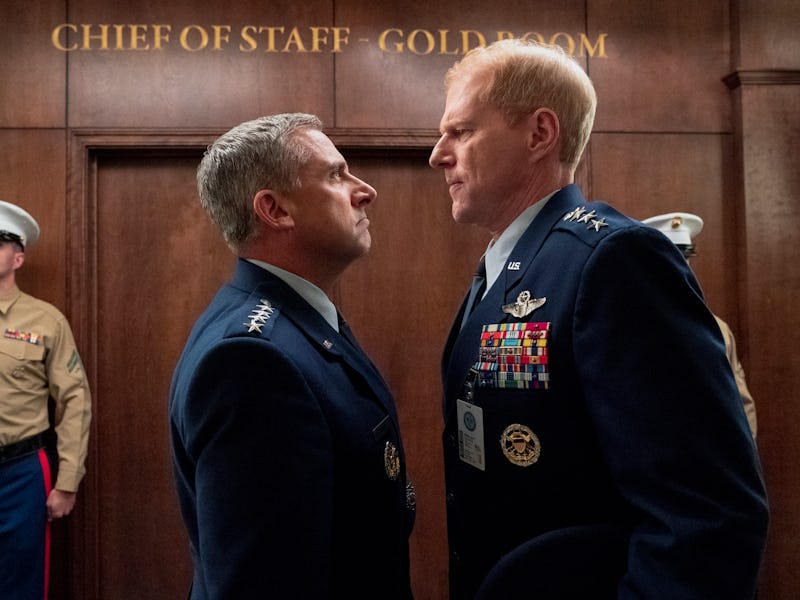Space Force: a show that fails to understand reality or anything else
Space Force doesn't seem to have a clue about the military's newest organization. That would be fine if it had anything to say.

What is Space Force, and what is Space Force? These are two very different questions, and the answer is unclear in either case. One is a division of the US military that acts under the Air Force, meant to establish American dominance in space. The other is a TV show starring Steve Carrell and John Malkovitch that is getting horrible reviews.
The two entities share a name and not much else. The fictional Space Force is a separate branch of the military, competing with the Air Force. It’s main goal is “boots on the Moon” as Carrell’s Mark Naird repeatedly declares, and is in constant competition with China. As an organization it is bare-bones, pulling janitors and welders who barely understand the concept of space to become astronauts at the last minute. Launches to the Moon go through years ahead of schedule.
The actual Space Force operates under the Air Force and is getting officers from the Air Force Academy. exists under the military and is currently more focused on Russian satellites with “characteristics of a weapon system,” to quote real Space Force Gen. John W. Raymond speaking in May. The actual Space Force also understands the basic mechanics of space travel, which make clear that early launches are logistically impossible. A recent NASA-SpaceX launch was scrubbed because the weather conditions were off by 10 minutes.
Steve Carrell in Space Force.
But these details would be minor if Space Force was able to unlock some deeper truth about the military’s 11th unified command. It does not. The show wildly vacillates between making fun itself—soldiers are heard chanting “I don’t know what I’ve been told / but outer space is very cold!,” one of the show’s few punchlines that land—and demanding respect for itself, like when a clear Alexandria Ocasio-Cortez stand-in, mostly referred to as “angry young Congresswoman,” gets her comeuppance for suggesting that sending an orange into space is too expensive.
The Department of Defense is America’s largest employer. Approximately the same number of people work for America’s military in one way or another as the entire population of Chicago. It’s a sprawling organization, in other words, which is why media about the military tends to focus on very specific groups: a single unit or division, something containable.
Space Force tries to focus on an entire branch of the military and gets lost in the shuffle as a result. The show sometimes focuses on bureaucratic budget fights, working with the private sector, finding psychologically suitable recruits for dangerous missions. None of these arcs have any continuity, or are interesting in the slightest. Naird’s trip out to a fake lunar colony, where he experiences the indignities of space diets and learns about the importance of emotional vulnerability, has its moments but is never repeated.
Why does this show exist? Co-creator Gregg Daniels has always focused on community. His work on The Simpsons, like “22 Short Films About Springfield,” focused on a wide cast of characters some lives intersected in the tiniest of ways, and then played up the absurdities of those intersections. Space Force casts a wide net, but its characters have no appeal. Why is Naird’s assistant, Brad, an incomptent one-star general who brags about terrorizing poor children? Why is Naird’s wife in jail, and why is the reason for her incarceration a mystery with no intrigue? Why is John Malkovitch’s scientist, Adrian Malloy, who is gay, given a romantic partner but the two are never seen together? Unlike The Simpsons or Daniels’ work on King of The Hill or The Office, the spread of characters on Space Force is paper thin.
The cold vacuum of space is the most challenging environment humanity has ever attempted to breach. It offers no survival mechanisms, no life, no sunlight, no oxygen, no gravity. The Moon offers gravity, but that’s it. Near the end, Space Force starts to make an argument that the only way anyone will survive this harsh terrain is by working together, through international collaboration. Both the Americans and the Chinese destroy each other’s bases, hypothetically leaving the two with no other choice but to work together.
But the show refuses to make even this political statement, cutting away as a cliffhanger of sorts. If this show were to fall off the edge of the Moon, I doubt few would miss it.
This article was originally published on